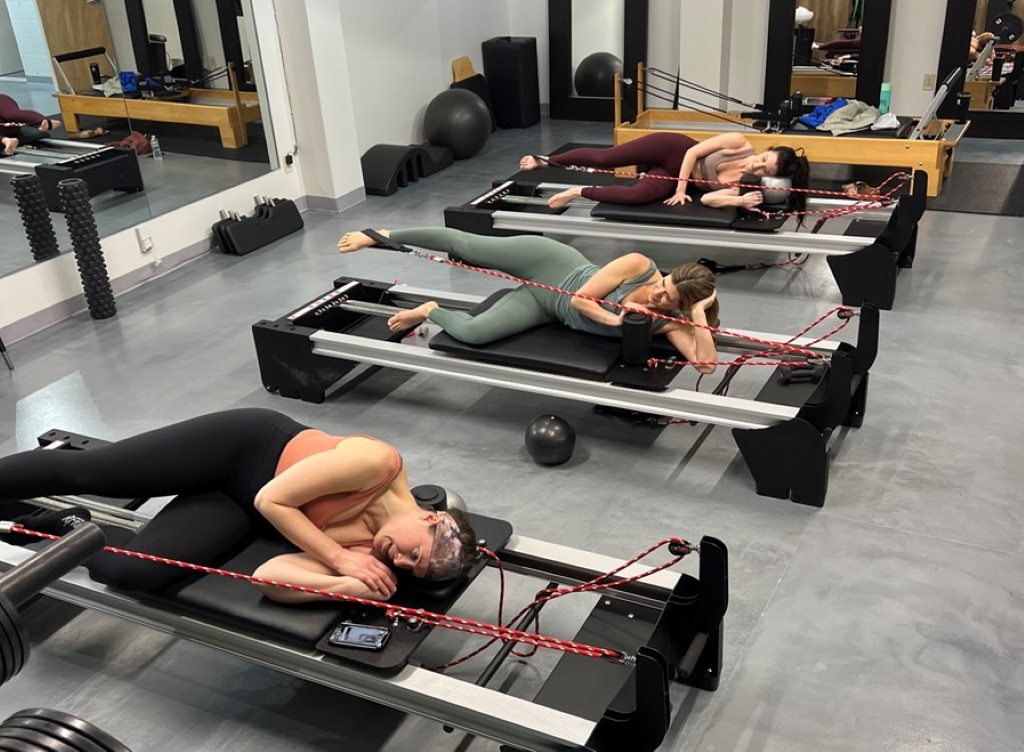Friday, February 23rd, 2024
When it comes to workouts that are both great for your body and accessible no matter your fitness levels, you’d be hard pressed to find a better workout than pilates. Often touted as responsible for the coveted figures of celebs including Jennifer Aniston and Cameron Diaz, pilates might just be your ticket to a stronger, more flexible, and balanced you. But what actually is pilates, and what makes it so great for your body? Let’s take a look.
What is Pilates?
Combining elements of yoga, ballet, and calisthenics, pilates (pronounced “puh-LAH-teez,”) is a fitness system that was created by Joseph Pilates in the early 20th century. It’s main goal? Strengthening your core muscles, improving flexibility, and enhancing overall body control. And while more advanced moves do exist, pilates exercises are generally designed to be low-impact, making them accessible to people of all fitness levels.
The Benefits of Pilates
So, what is pilates good for? Here are just a few advantages:
Improved Core Strength
At the heart of Pilates lies the concept of core strength, and this tends to be achieved with exercises designed to target your deep abdominal muscles, obliques, and lower back – in turn, giving you a stronger and more stable core. With improved core strength, you don’t just benefit from a flatter stomach, but you can also alleviate back pain, improve your posture, and enhance your overall balance and stability.
Increased Flexibility
Pilates also involves a range of stretching exercises that help increase your flexibility, which means that over time you’ll find yourself moving with greater ease and grace. Not only is flexibility an advantage when practicing other fitness methods, but this newfound flexibility can also prevent injuries and provide relief from muscle stiffness, making your everyday activities more comfortable.
Muscle Tone and Endurance
Pilates isn’t just about core strength, it also works wonders on muscle tone and endurance – hence that tight, toned, and trim look that you might find on the many who swear by the method! By engaging various muscle groups in a controlled manner, pilates can help you develop long, lean muscles and greater stamina – so say goodbye to bulky muscles and hello to a sculpted physique!
Posture Enhancement
Finally, pilates can even help when it comes to posture; in our digital age, many of us find ourselves slouching over screens, living sedentary lifestyles, or sitting at our desks for up to 7 hours a day, all of which are terrible for our posture and spine. With consistency and regular practice, pilates can help correct this by strengthening the muscles that support your spine; you’ll stand taller and feel more confident in your body, whether you’re at work or on the dance floor.
Cardiovascular Benefits
We all know about the link between fitness and heart health, and while pilates is low-impact in nature, that doesn’t mean you won’t be working up a sweat nonetheless! While calorie burn will vary based on your weight, experience, and the intensity of your movements, you can expect to burn anywhere between 170-250 calories in an hour-long session.
Pilates for Mind-Body Wellness

Aside from the many physical benefits of practicing pilates, this fitness method also offers a range of mental and emotional advantages:
Stress Reduction and Mental Focus
Given its yoga-inspired roots, pilates emphasizes mindful movement and concentration; performing precise exercises with attention and control can do a great deal to free up your mind from daily stressors, and you may find yourself letting go of worry and anxiety during your session. Put simply, it’s a form of meditation in motion, allowing you to center your thoughts and boost mental clarity – all while working towards your most balanced and healthiest self.
Breath Control and Relaxation
If you suffer from anxiety or chronic stress, you might already know a little bit about breath work – but did you know that breathing is also an integral part of Pilates? Learning to synchronize your breath with each movement not only maximizes the effectiveness of the exercises but also induces a sense of relaxation, making a pilates class a fantastic way to unwind and release tension after a hectic day.
Who Can Benefit from Pilates?
All Fitness Levels
Whether you’re a fitness newbie or a seasoned athlete, Pilates can be tailored to meet your needs, and iInstructors can modify exercises to challenge advanced practitioners – or equally, provide gentler variations for beginners.
Rehabilitation and Injury Prevention
Pilates is often recommended for rehabilitation purposes, as its focus on enhancing flexibility and core strength can be useful in the recovery process. Pilates can even help you prevent future injuries by strengthening weakened areas of your body and improving your overall body alignment.
Incorporating Pilates into Your Routine
Ready to give Pilates a try? Here’s how you can seamlessly integrate it into your fitness routine for a healthier and happier you.
Find a Class
Start by exploring local fitness studios or online platforms that offer Pilates classes; joining a class can provide you with expert guidance and a motivating group environment. At Fit Flex Fly, we offer everything from beginner pilates to more intense combo workouts. For example, if you’re looking to lose weight, you can even watch your body transform with pilates HIIT workouts that blend cardiovascular exercises with pilates movements.
Private Sessions
If you prefer the comfort of your own space, we at FitFlexFly offer one-to-one sessions where you can reap the benefits of a pilates workout without worrying about messing up your moves in front of a crowded class. We also offer small group classes, so whether you’re into mat pilates or reformers, you can even bring a friend and discover the benefits of pilates together!
Consistency is Key
To reap the full benefits of Pilates, consistency is key, so we’d recommend aiming to practice Pilates 2-3 times a week. Consistent practice will help you see and feel the positive changes in your body – and the mirror!
Combine with Other Workouts
Pilates complements other forms of exercise perfectly, whether it be weight-lifting, cardio or your favorite sport, so don’t hesitate to incorporate it into your existing fitness routine. For example, you could try following up a cardio session with a Pilates workout to cool down and improve flexibility.
Listen to Your Body
Finally, pilates is all about mindful movement. Pay close attention to your body, and don’t push yourself too hard, especially if you’re just starting. Gradually increase the intensity as your strength and flexibility improve, and get ready to watch your body – and your physical strength – transform!

